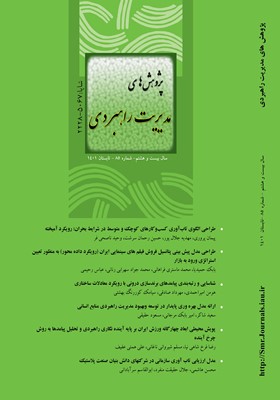شناسایی و رتبهبندی پیامدهای برندسازی درونی با رویکرد معادلات ساختاری (مورد مطالعه دانشگاه آزاد اسلامی واحد خوراسگان)
محورهای موضوعی : پژوهش های مدیریت راهبردیهومن امیراحمدی 1 , مهرداد صادقی 2 , سیامک کوررنگ بهشتی 3
1 - دانشجوی دکتری مدیریت و برنامه ریزی فرهنگی، دانشکده حکمرانی اسلامی ، واحد اصفهان(خوراسگان) ،دانشگاه آزاد اسلامی، اصفهان،ایران
2 - استادیار ،دانشکده حکمرانی اسلامی ، واحد اصفهان(خوراسگان) ،دانشگاه آزاد اسلامی ، اصفهان، ایران
3 - استادیار ،دانشکده حکمرانی اسلامی ، واحد اصفهان(خوراسگان)، دانشگاه آزاد اسلامی ، اصفهان، ایران
کلید واژه: دانشگاه آزاد اسلامی, معادلات ساختاری, برندسازی, برند درونی,
چکیده مقاله :
دانشگاهها در مواجه با توسعه اقتصاد کلان و نیازهای اجتماع محلی با مشکلات متعددی روبه رو هستند. جهت بقا در بازار آموزش عالی لازم است خطمشیهایی تدوین کنند که آنها را به عنوان ارائهدهنده خدمات آموزشی، و دانشجویان، استادان و کارمندان را به عنوان مهمترین ذینفعان مستقیم در نظر بگیرد به همین دلیل بررسی اثرات برندسازی درونی لازم است لذا هدف از این تحقیق شناسایی و رتبهبندی پیامدهای برندسازی درونی با رویکرد معادلات ساختاری دانشگاه آزاد اسلامی واحد خوراسگان بوده است. پژوهش حاضر یک پژوهش کاربردی و از نظر روش انجام یک پژوهش آمیخته(کیفی- کمی) میباشد. جامعه اماری پژوهش تعداد 12 نفر از خبرگان می باشد. که در بخش کیفی از نظرات آنان جهت شناسایی پیامدهای استفاده شده است و جهت مدلسازی نیز جامعه آماری را جمعی از کارشناسان و اساتید دانشگاه خوراسگان تشکیل میدهند که تعداد آنها 440 نفر بوده است سپس با توجه به جدول کرجسی و مورگان، حجم نمونه 205 نفر به دست آمد. روش نمونه گیری در این پژوهش، نمونه گیری در دسترس می باشد. اثرات برند درونی ابتدا با تکنیک دلفی شناسایی شده است سپس با تکنیک معادلات ساختاری و تحلیل عاملی تأییدی مدلسازی و رتبه بندی گردیده است و در نهایت نتایج تحقیق نشان داد اثرات برندسازی درونی دانشگاه خوراسگان 6 پیامد عمده برای سازمان دربردارد که به ترتیب اولویت عبارتند از پیامدهای سازمانی، پیامدهای ملی و بین المللی، پیامدهای فردی، پیامدهای مالی، پیامدهای فرهنگی و در نهایت پیامدهایی برای کارکنان.
In times of economic crisis, businesses and individuals take on more responsibility for higher education institutions; Higher education institutions are expected to have more efficient graduates and to be able to better meet the needs of employers. Universities face many challenges in developing macroeconomics and the needs of the local community. In order to survive in the higher education market, it is necessary to formulate policies that consider them as providers of educational services, and students, faculty and staff as the most important direct stakeholders. Therefore, it is necessary to study the effects of internal branding. From this research, the consequences of internal branding have been identified and ranked with the approach of structural equations of Islamic Azad University, Khorasgan branch. The present study is an applied research and in terms of the method of conducting a mixed research (qualitative-quantitative). The statistical population of the study is 12 experts. In the qualitative part, their opinions have been used to identify the effects and for modeling, the statistical population consists of a group of experts and professors of Khorasgan University, whose number was 440 people. Then, according to Krejcie and Morgan table, the sample size 205 people were obtained. Sampling method. In this research, sampling is available. Internal brand effects are first identified by Delphi technique, then structural equations and confirmatory factor analysis are modeled and ranked. Finally, the results showed that the internal branding consequences of Khorasgan University have 6 major outcomes for the organization, which are in order of priority. Organizational, national and international implications, individual implications, financial implications, cultural implications, and ultimately implications for employees.
آزاد، ناصر، فاطمی فر، آزاده، قائم مقامی فراهانی، خدیجه (1397) شناسایی اجزای DNA برند در آموزش عالی (مطالعه موردی دانشگاه آزاد اسلامی)، مدیریت کسب وکار، 10 (37) .7-33
باقری، سید محمد، حسینی، سید محمود، سورنا، آریایی (1399). تاثیر برندسازی درونی برجایگاه یابی برند شرکت های کوچک و متوسط استان مازندران، بازاریابی پارس مدیر، شماره15 .28-38
رحیمیان، اشرف (1397). برندسازی دانشگاه؛ نیاز جدید آموزش عالی (مطالعه موردی؛ دانشگاه پیام نور مرکز کرج)، مدیریت و برنامه ریزی در نظام های آموزشی،11(1) . 158-139 .
شفیعا، سعید؛ سید نقوی، میرعلی (1398). الگوی برندسازی درون سازمانی در بخش خدمات و گردشگری تهران، مطالعات مدیریت گردشگری، دوره 14 ،شماره 46 ، 109-79 .
منوریان، عباس؛ صفویه، جواد؛ آقاخانی، نرگس؛ رضایی نور، جلال (1396) .بررسی عوامل مؤثر در تدوین استراتژی های برندسازی دانشگاه های مبتنی بر آموزش الکترونیکی، دوره 11 ،شماره 3 ، .221-236
Clark. Paul, Chapleo. Chris, Suomi. Kati,(2019), Branding higher education: an exploration of the role of internal branding on middle management in a university rebrand, Tertiary Education and Management, https://doi.org/10.1007/s11233-019-09054-9, pp: 1-19.
Hosseini, M.H. & Farhadi Nahad, R. (2013), Investigating Effective factors Brand Value in higher education (case study: Payame Noor University), Modisiat-e Farda, 12 (35).
Kashive. Neerja, Khanna. Vandana Tandon ,(2017), Impact of Internal Branding (IB), Brand Commitment (BC) and Brand Supporting Behavior (BSB) on Organizational Attractiveness (OA) and Firm Performance(FP).,International Journal of Human Resource Studies ISSN 2162-3058 2017, Vol. 7, No. 2,pp 155-174.
Leijerholt. Ulrika, Galina Biedenbach &Peter Hultén(2021) Internal brand management in the public sector: the effects of internal communication, organizational practices, and PSM on employees’ brand perceptions, Public
Management Review, ,https:// doi. org/10.1080/14719037.2020.1834607
Mihaelaa, Diaconu. Amalia, Pandelica (2012), “The partnership relationship between economic academic and business environment, component of modern university marketing orientation”, Procedia - Social and Behavioral Sciences 62,
722 – 727.
MacLaverty N, Goom S, McQuillan P, Oddie H; (2008), Internal Branding – A Human Resources - Perspective, Canadian Marketing Association.
Raj P. D, Cheryl L. B, Timothy W. A, & Kimberly M. J (2010), “Building brand community-membership within organizations: a viable internal branding alternative?” Journal of Product and Brand Management, 19 (3), PP: 210-217


